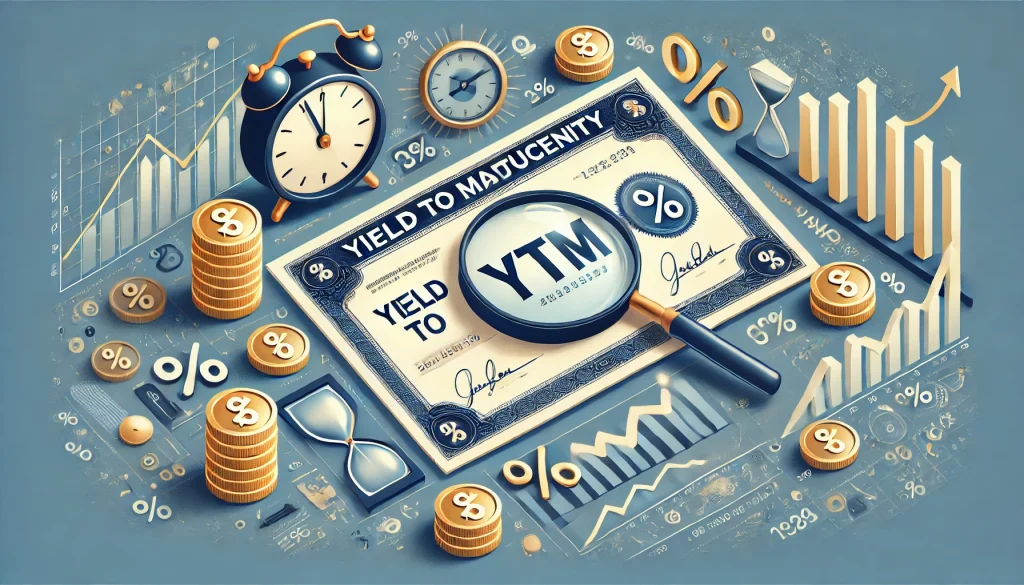
Bond investing may seem confusing for beginner investors, but it is essential to spend time decoding what is YTM. It acts as a vital metric whenever calculating the potential returns of bonds. Yield to Maturity gives the estimated overall returns assuming that a bond owner will maintain their possessions until maturity. This guide will demystify YTM and discuss its calculation method and various components, helping you comprehend how to predict fixed-income returns.
What Is Yield to Maturity?
YTM is the measure that gives an investor’s overall return from a bond if they hold it until maturity. While computing the YTM, you must consider regular coupon payments and potential capital gains or losses. Eventually, it helps assume the potential performance of a bond realistically throughout its lifespan.
What Are the Key Components of Yield to Maturity?
Each component of the YTM significantly contributes to the final bond return calculation. These include:
- Coupon Interest Rate
It is the interest you get by holding bond units. You can see the coupon interest rates as percentages of the actual bond face values.
- Time to Maturity
Another key component that determines the YTM is the time left until a particular bond reaches its maturity date. This is also the time when the issuer repays the principal amounts of all those who stayed invested throughout the bond term.
- Current Market Price
It denotes the prevailing market price at which you can buy the same bond units from the secondary market. It can be lesser, more or even the same as the bond’s initial value or face value.
Why Is Yield to Maturity Important?
One can realise the importance of yield to maturity while comparing multiple bonds. Based on this single metric, investment experts can guide you on which bonds may prove to be beneficial in fulfilling your financial goals. The YTM indicates several price appreciation trends of your bond investments over the upcoming years. It helps you visualise how the different market conditions can influence your portfolio all with the help of a single figure.
Unravelling the YTM Formulas
You have a predetermined formula to calculate the value of yield to maturity.
Here’s the formula:
YTM = [Annual Interest + (Par Value – Market Price) / Number of Years to Maturity] / (Par Value + Market Price) / 2
In the above equation, the annual interest is the coupon rate of a bond, whereas the market price denotes the particular bond’s current market value. Finally, the years to maturity is defined by the number of remaining years from the bond expiry date.
Yield to Maturity Calculation Example
For a real-time example, let us assume the following values:
- Yearly coupon rate or interest rate of a bond = 6%
- Par value of the bond or the price at which you purchased it = ₹1,000
- Prevailing market value of the bond = ₹600
- Years left until maturity = 3 years
- Annual coupon payment of the bond = ₹60
Accordingly, the Yield to Maturity will be:
[60 + (1000 – 600) / 3 * 100] / [(1000 + 600) / 2] = 16.74%
Now, let us assume that the market value of the same bond has increased to ₹750. As a result, the YTM will change too.
New YTM = [60 + (1000 – 750) / 3 * 100] / [(1000 + 750) / 2] = 9.58%
Although a crucial metric, the yield-to-maturity has a few limitations as well. These drawbacks are discussed as follows:
- While calculating the YTM, we assume the future coupon rates and bond values. Therefore, the final yield can immensely vary as bond prices can never be precisely anticipated due to market downturns.
- Additionally, the person calculating YTM assumes that the profits earned will be reinvested at the same interest rate. This often falls short of reality as fluctuations in bond rates often exert a substantial impact on individual decision-making.
Besides the above-mentioned primary reasons, a high yield-to-maturity cannot necessarily be an indicator of impressive returns. It primarily denotes low market prices of bonds and can seem to be a major discouragement for investors, who would like to maintain their investments until maturity.
Final Word
Understanding what is YTM is very much essential as it is a key metric associated with bond investment. It helps partially determine potential returns and shows if a bond is overpriced or underpriced. However, it is crucial to consider the limitations of YTM too and consult additional key metrics for a foolproof investment decision.
Frequently Asked Questions
A low yield-to-maturity value for bonds is more favourable for investors who do not want to take too much risk. On the other hand, if you are willing to take a reasonable amount of risk then you may stay invested in high-yield bonds that can potentially give high returns.
The best YTM rate for you depends on your financial goals and how much risk you are willing to take. Besides this metric, you should also consider other aspects like the bond type, coupon rate and bond equivalent yield while selecting a bond for investment.
A high yield-to-maturity can be an indication of more risk as they are generally associated with junk bonds. Therefore, if you are eyeing a high-yield bond, it is highly recommended to check the credit rating of the bond issuer before investing.
High YTM bonds carry more risk of default and are more volatile at times of economic stress. Therefore, if you are not sensitive to temporary market downturns then you can invest in high-yield bonds besides sovereign and investment-grade bonds.


